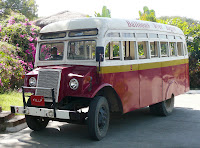 Pardon the idiom, but the ATR aircraft of Air Mandalay really do “haul ass” as they travel the tourist milk run up from Yangon to Heho, Mandalay and Bagan.
Pardon the idiom, but the ATR aircraft of Air Mandalay really do “haul ass” as they travel the tourist milk run up from Yangon to Heho, Mandalay and Bagan. The aircraft are comfortable, the flight crew hard working, friendly and attentive, serving snacks and drinks on their short flights. After a very enjoyable stay at Inle Lake, we resumed our journey north from Heho to Bagan – this time via Mandalay.

On the ground at these hole in the wall airports there is strict passport control as Myanmar's officials keep a close eye on the whereabouts of its visitors. When we arrived at Heho Airport our guide dealt with the Air Mandalay ground agent, returning with passports, boarding passes and baggage tags.
A virtual army of baggage handlers organized the luggage in the cramped terminal for its various destinations, putting each piece through antiquated x-ray equipment. No need to reveal liquids and creams here – everything goes through the big black box and comes out the other side.
Passenger “examination” awaits behind colourful curtains but in spite of the anticipation, we were quickly waved on through more curtains to the other side and a crowded departure lounge. There were two flights ahead of us.
As an arriving Yangon-bound Air Bagan aircraft taxied to the small terminal building the noise from the propellers blasted us. We realized that some of the terminal’s window panes were missing and a funnel of dust forced the tarmac exit door open. As it banged against the wall, an airport official who appeared unfazed by the interruption continued his task of completing passenger details in a well-worn ledger.
And then our flight was called by a young lady who held a handwritten sign with our flight number high above her head.
Observing the departure etiquette for previous flights and the initiative shown by the European contingent in the departure lounge, as soon as we caught sight of the incoming Air Mandalay flight we formed the front of the line at the exit door –while a boarding pass was provided there was no seat assignment and storage space on the aircraft is limited.
On the 20 minute layover in Mandalay the captain came back into the cabin to eat a boxed lunch and the plane filled up again for the final leg from Mandalay to Bagan. The luggage compartment was open ahead of us and it was comforting somehow to see our bags stowed three feet ahead of us.










 On arrival at the Maetaman Elephant Camp north of Chaing Mai, a large sign warns
On arrival at the Maetaman Elephant Camp north of Chaing Mai, a large sign warns





 Up the hill at the main hotel complex, the outlook is just as idyllic.
Up the hill at the main hotel complex, the outlook is just as idyllic. 











